
When the famous explorer of tragic death Roald Amundsen, first to reach the South Pole during his epic Antarctic expedition in 1912, headed for the opposite end of the globe (90º north) sailing on the Italian zeppelin Norge, he made a last stopover in Vadso, where the mast is still on foot that serviced the airship. Amundsen, one of those real adventurers that existed before the era of credit cards and mobile phones put an end to such job, disappeared forever in the Barents Sea two years after later, ironically during a rescue mission; and so he found his grave in the snowy and icy latitudes he had so much loved.
Today I’m visiting that island of drinking water (such is the meaning of Vadsoya) and thus pay a small tribute to those explorers who did not hesitate in sacrificing their lives–in exchange, yes, for glory, but mostly following their passions.
It is a cool and cloudy morning when I put my few belongings into Rosaura’s cases and, heading for the Norwegian border, leave behind the cozy reindeer farm Toini Sanila. The weather change has settled, and I’ll be riding for the next few weeks on the full lined jacket, which now leaves some emptiness in the topcase. Before crossing the border I make a stop at Näätämö for refueling and drinking a tea; actually nothing else can be done here: Näätämö is just that, a motel and a gas station. By the way, I should have refueled yesterday in Inari, because here, Norway being round the corner, fuel is twelve cents more expensive.
This is my farewell to Finland for a few weeks, until God knows when, as I have no idea where shall my steps take me, or perhaps Rosaura’s–as sometimes I believe it’s she who steers me. There are five or six people in the kahvila, either lunching a hot dog or sipping a coffee. I order tea with a bun, then sit at a table and warm up my hands with the glass. It’s a well heated cafeteria. In this land it’s not unexceptional, I guess, to turn the heating on by beginning of August. Here’s a toast to the health of Lapland. From now on it will be Norway, the world’s most expensive country. I have some qualms about the prices, knowing not how long I’ll be able to stay before my budget cracks. But anyway, it won’t be a big issue because Sweden is never farther than fifty kilometers. Now it’s time to keep going.
Right on the border there’s no other sign than a small plate saying Norge, without the yellow starred ring because I’ve just left the EU, though this is still Schengen territory for free transit of people, goods and money. Only a few kilometres farther I make the first stop in this country, by the bridge over Njávdánjohka, which makes a cute waterfall before flowing into Munkefjord. There are a few cars in the parking lot with Finnish or Norwegian plates, and people are taking photographs. From here on and along the next 130 km the landscape will change drastically. Woods will lose their prevalence and yield to a desolate tundra.
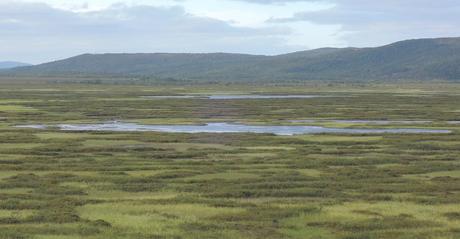
Tundra will be the prevailing landscape for the next few days’ journey
Roads are also going to change: more winding, narrow and worn out. It is said that Norwegians are stingy because, wealthy as they are, they don’t spend a dime in repairing their roads; but I don’t believe so; rather I think they’re more like Canadians: having thousands of kilometres of roads under extreme winter conditions, they can’t keep up with repairs. In fact, I’ll come across many more stretches under construction in Norway than in Finland.
Forty kilometres further, for the first time in my life I catch sight of the Arctic ocean in its full beauty. And I mean in its full beauty because technically I had seen it before, when I went by Akureyri during my epic trip around the Hring Végur, the Icelandic ring road, though in that time I barely managed to see the dark stripe of Eyjafjord flanked by steep snowy hillsides. That’s why I now gaze at the Arctic as something new to my eyes, shallow and calm, with turquoise hues I hadn’t imagined which tell of an abounding marine life.
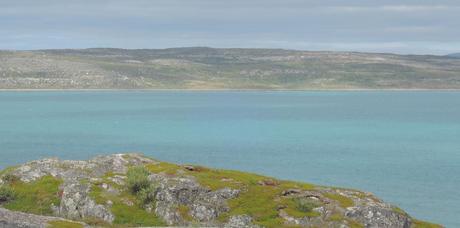
The Arctic, for the first time before my eyes
Being the tides so strong in this part of the globe, and the incline so soft, at the ebb large strips of seabed get exposed, as wide as half a mile or more in some places, and on these huge marshes the kingdoms of sea and land meet, bustling in rich and diverse wildlife.
As I was enjoying my first observation of the Arctic ocean from a viewpoint unsheltered from the cold wind, a man addresses me who was around there, apparently doing the same. He’s a nice Norwegian who welcomes me to his country and says he lives not far from North Cape, only in the near peninsula to the east, Nordkinn, which rivals with her sister Knivskjellodden the record of enclosing the northernmost tip of the continent, he kindly explains to me on a map. Despite Nordkapp being the European cape closest to the pole, it happens to be on Mageroya island, therefore separated by a stripe of sea from the continent; thus, strictly speaking, Kinnarodden cape is the northernmost one in the continent (this is the key point). Which is actually but a trivial local rivalry, because in fact the difference between both tips is less than two minutes’ latitude, i.e. two nautical miles.
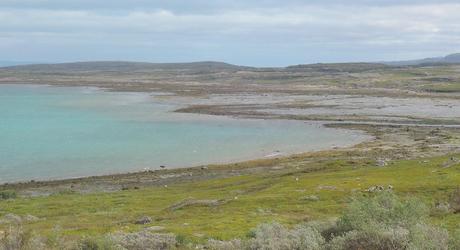
Large marshlands get exposed at the ebb of tide in the Norwegian Arctic
He has a warm look about him, this blue-eyed Norwegian, but there’s something more to his look than just affection; something I haven’t yet fingered when we shake hands to say goodbye. I’d have liked to talk a bit longer with him, as I not too often have the chance of enjoying a fine chat, but it’s cold here and there’s not a shelter.
Only a few kilometres farther on, I stop again by an even nicer landscape, and as I’m taking some shots here arrives the guy in his car and parks by the motorcycle. Apparently–think I–he’s also in need of a longer chat. Together we contemplate the beach and the islets for a few minutes, then I ask him about Finnmark county–this part of Norway–just in case he has some sightseeing tips for me. Sure, he says; but as this chill wind doesn’t gives us a break, we get into the car for his suggestions. He unfolds his map and shows me around, here the peninsulas, here the roads, he recommends the one going up through Nordkinn towards Gamvik because–he says–its as beautiful as the one to Nordkapp, yet not so busy, much less touristic. There, along that road, he has a summer cottage–he adds, as if inviting me. For the moment being–says I–I’m going to Vadso, but if I decide on taking the route you’re suggesting, I wouldn’t mind to drop by for a beer. Then he looks at me again from behind his blue eyes that sparkled with a fleeting joy; and before he can speak an answer, as I gaze his glance, I get a glimpse of what I had not a while ago, of what throbs beyond his warmth: it’s something intrusive, almost invasive; then I suddenly understand, before he explains…
These days back–he tells me–I’ve had my boyfriend at the summer cottage, whom I’ve just seen to the Kirkennes aerodrome; so, I wouldn’t mind to spend a nice while with a foreigner if he pays me a visit. He stares at me to check how much I’ve been impressed by his words, and this time I find his gaze almost aggressive. Unperturbed, I reply I’m not in that business, but I have no inconvenience to drop by his place for a coffee and some conversation. And so the subject is settled because the track to his cottage–he adduces–is a very rough one, barely passable for a four wheeler, leave aside a bike like mine.
When I step off his car I shake his hand again and wish him good luck, while inwardly cursing mine: why I don’t like men? Only queers come along so near me.
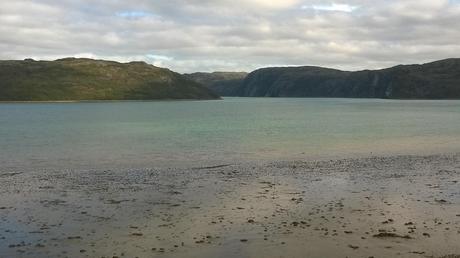
A beach in Varangerfjord
At the end of the fiord I’ve been skirting for the past forty kilometres there is Varangerbotn, a tiny settlement of barely thirty houses around a gas station, a hotel and two restaurants. Despite being so small there’s some life around this place because here is the junction where the service road from Vadso, Vardo and other 150 km with several shipping villages south of Varanger peninsula joins the main route. I seize the chance for a short stopover in Jagerstua Vertshus, a quite inviting restaurant and souvenir shop where, among the half dozen spread out customers sitting at the tables I can spot some travelers, out of that subtle but unmistakable pose, that special demeanour we so well make out, like if saying: here I am, an inured and experienced fellow getting ready for new, unheard of adventures.
Jagerstua Vertshus is going to provide me with a first encounter with Norwegian prices: a teabag plus a slice of cake, fourteen euros. I was made aware of coming across disproportionate prices, but the rip off surpasses all forecasts: it’s about four times more expensive than Spain, and about ten times the same thing in Poland. Also, and oddly enough, despite Norway having oil, gas is also considerably more expensive than anywhere else: two euros per litre. But well, this is the deal and I’d rather get used to it unless I want to spoil my stay.
Fifty kilometres east of the junction I finally reach Vadso, my goal for today. It’s a small town of about six thousand inhabitants, offering several acommodation, two gas stations and a small variety of restaurants. Though most of the town lays along the peninsula’s coastline facing south, the original settlement from XVIth century was on the small island right across the bridge: Vadsoya.

Vadso seen from Vadsoya island, where the first settlement was
Now, this is going to be my real first contact with the country and its people, Norwegian society and their habits.
The main hotel in town is Scandic Vadso, right in the “centre”, but as we’re in the three figures herForty kilometres further, e, the receptionist very kindly suggests me to try Lailas Gjestehus, in Vadsoya islet right across the bridge. However, before going there I try my luck in a couple of guest houses I’ve seen around here, the kind of place that has a hand written sign advertising rom, rooms, which I presume sensibly less expensive. But the fromirst one is under refurbising and I don’t want to be woken up by early morning noises; and as to the second, the landlady doesn’t take credit cards and I don’t have Crowns yet. So, instead of going hunting an ATM, I say to myself, what the hell?, let’s try that Lailas Gjestehus over in Vadsoya and see how I like it; if it’s below one hundred I’ll take it.
Lailas is a pleasant family hotel, inviting and well equipped, placed on a privileged, unbeatable location in the islet: on its northern shore, surrounded by nature and featuring great views of Vadso and the fiord. (By the way, a fiord, so fine and select as it sounds just because this is Norway, is nothing but a sea inlet.) The owner welcomes me behind the desk with a nice smile. Yes, there are vacancies; no, we haven’t single rooms, but as you travel alone let’s make it eighty for a double, is that ok? Or if it’s still too expensive for you, as I know Norwegian prices are really high for foreigners, I can call to a cheaper place downtown and book a room on your behalf… Wow! That’s extremely kind of her, revealing a praiseworthy lack of greediness; but the fact is, I like this hotel and the room is neat with a great view, so we have a deal.
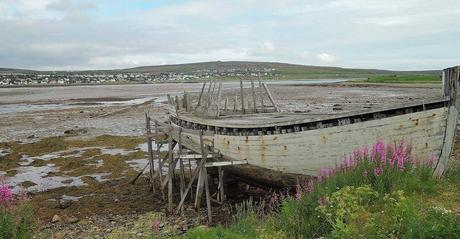
A shipwreck on the fiord’s beach by my hotel
After a good hot shower I go exploring Vadso. By XVIth century it was just a small fishing settlement on Vadsoya, which later on developed from barter trade with Russia and moved to the mainland. Nowadays it’s a pleasant and quiet town, mostly on wooden houses arranged along three or four streets layn out parallel to the seashore, and walkable in one hour. First thing I do is withdraw cash; second, get myself a Norwegian SIM card, which has been straightforward and easy. Then I’ve looked for a restaurant, but it turns out there’s not a single one with national food: you have two Italian pizzerias, a Turkish, a Hindi, a burger and a hot-dog stand, but nowhere to try some local speciality, nor even some fish dish. When I ask my landlady she explains to me: Norwegians go out for eating something different than home made food, so they appreciate some change and therefore favour foreign cuisine. What about the tourists?–I ask. Well, that’s the problem–she replays–: tourists would like to try something typical from here, but nobody in town seems to be interested in starting a Norwegian restaurant.
Yet, there’s another one thing strongly calling my attention (and probably related with the above): the abundance of immigrants in Vadso from other races. You can see blacks, moors, Indians, Turkish, yellows… I wouldn’t have expected in such a cold country, in so small and remote town. I had thought–my ignorance, of course–Norway would be almost free from poor countries’ immigrants, as it doesn’t belong to the EU and doesn’t have to comply with our charitable and compassionate social policies. Now, thinking it twice, I realize it just makes sense: Norwegians are so rich, they don’t even take jobs for the poorly qualified; and this way there’s an empty niche ready to be filled by immigrants ready to work as anything and to open pizza places or kebabs where the others can go for dinner something different from their home diets. This way everybody’s happy.
Finally, I visit the mast where the airship Norge in the Amundsen expedition was docked in 1926 before crossing the north pole: it’s still standing on the wildlife sanctuary and anthropological reserve taking up the whole eastern half of Vadsoya islet. Right there, at one of its three pole’s foot, there’s a conmemorative plate reminding that expedition and the airship’s crew. It was a different breed of explorers. I don’t say there is no more people like those, but is there any unexplored corner left in the planet?
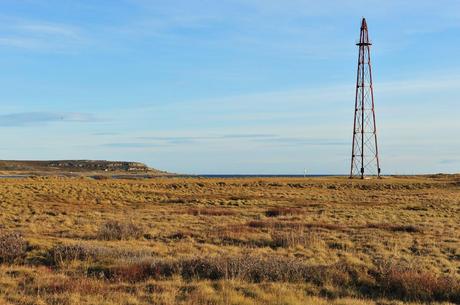
The “luftskipsmasta” (photo by Geby)
Strolling through this small ecological reserve and bird observatory I run into an open wooden shelter in quite good shape, for the people to use it but not to abuse it. Unfortunately some of my fellow countrymen have been here leaving a footprint to the shame of Spain: sharcoaled scripts pro and against football teams. I just wonder, what the hell do Norwegians care about the provincial quarrels in one of the most African countries in Europe?
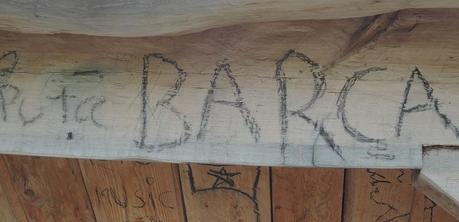
My compatriot’s funny shenanigans
previous chapter
img class=”wp-image-6799″ src=”http://freelander.es/wp-content/uploads/2015/01/vadsoBarco.jpg” alt=”El viejo casco de un barco pesquero varado en la ría junto a mi hotel” width=”650″ height=”339″ /

